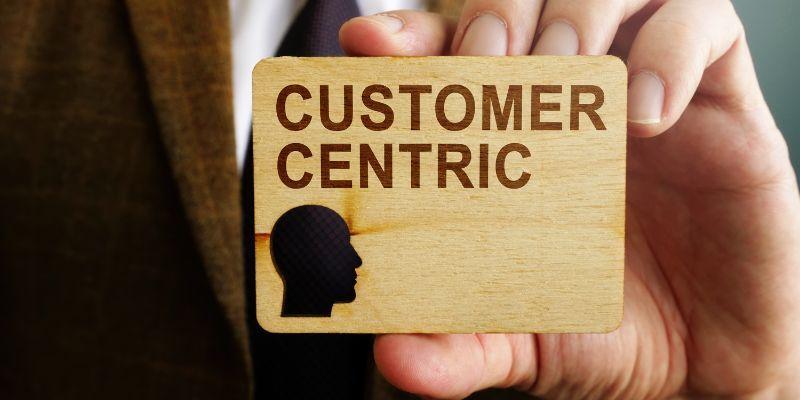First impressions are critical in business. You often have just one chance to win over a new customer. If you notice that moment, you can regain their interest or trust.
In today’s marketplace, customers increasingly value their experience with a brand over the perfection of the product or the strength of the brand’s name.
Instead of just looking for the best product, customers now prioritize how a company makes them feel throughout their buying journey.
According to recent studies, more than 80% of customers say that a company’s experience is as necessary as its products and services when deciding where to spend their money.
This shift underscores the need for businesses to adopt a Customer-Centric Strategy to stay competitive and successful.
This article will explore the concept of a Customer-Centric Strategy and why it has become essential for businesses today.
We’ll examine the principles of customer centricity and how they differ from traditional business models and other concepts.
What is a Customer-Centric Strategy?
A Customer-Centric Strategy is a business approach that prioritizes customers’ needs, preferences, and experiences at every stage of the business process.
Unlike traditional business strategies that often focus on product development, sales targets, or market share, a customer-centric approach places the customer at the heart of every decision.
The goal is to build lasting customer relationships by consistently delivering value and ensuring a positive experience throughout their interaction with the brand.
In a customer-centric business, success is measured by the volume of products sold and the level of customer satisfaction and loyalty. This strategy involves deeply understanding customers’ needs and expectations and tailoring products, services, and communication to meet those needs effectively.
A customer-centric approach is about proactively anticipating customer needs, resolving issues quickly, and creating a memorable experience that keeps customers returning.
In contrast, traditional business strategies may focus more on the product, striving for product perfection or brand recognition without considering the customer’s experience.
However, as customer priorities have shifted, with more emphasis on the overall experience rather than just the product, businesses are increasingly adopting customer-centric initiatives to stay competitive.
This shift highlights the growing importance of cultivating a customer-centric culture where the customer’s voice influences every aspect of the business.
Why Is It Important?

The importance of a Customer-Centric Strategy cannot be overstated in today’s business environment. As customers increasingly value their overall experience with a brand, companies that fail to prioritize customer needs risk losing out to more customer-focused competitors.
A customer-centric approach helps attract and retain customers and builds long-term loyalty, leading to repeat business and positive word-of-mouth referrals.
By placing customers at the center of all decision-making processes, businesses can better understand their target audience, anticipate their needs, and deliver personalized experiences that resonate on a deeper level.
This approach also enables companies to respond quickly to market changes and customer feedback, ensuring their offerings remain relevant and valuable.
Customer centricity drives customer satisfaction, promotes trust, and contributes to sustainable business growth. It’s no longer just about selling a product; it’s about creating a relationship that benefits both the customer and the company.
The Customer-Centric Mindset
Adopting a customer-centric mindset throughout an organization is essential for successfully implementing a Customer-Centric Strategy. This mindset ensures that every employee, regardless of their role, understands the importance of the customer and is committed to meeting their needs.
To cultivate this mindset, businesses can implement several strategies:
- Leadership Commitment: Leadership must model a customer-first attitude, demonstrating the importance of customer satisfaction in every decision.
- Employee Training: Regular training programs can help employees develop a customer-centric attitude, equipping them with the skills and knowledge to deliver exceptional service.
- Clear Communication: Communicate the company’s customer-centric vision clearly and consistently, ensuring all employees understand how their roles contribute to the overall customer experience.
- Incentives and Recognition: Reward employees who exemplify customer-centric behavior to reinforce the importance of this mindset.
Aligning employees with a customer-centric vision ensures that the organization works cohesively to exceed customer expectations and improve customer satisfaction and business success.
How to Implement a Customer-Centric Strategy?

Implementing a Customer-Centric Strategy involves intentionally aligning your business processes, culture, and goals with your customers’ needs and expectations.
By focusing on understanding your customers, defining clear customer personas, mapping out their journey, and aligning your organization around these insights, you can create a uniform and positive customer experience.
Below, we’ll detail these steps to help you successfully implement a customer-centric approach in your business.
1. Understand Your Customers
Understanding your customers is the foundation of a Customer-Centric Strategy. Thorough customer research and analysis allow you to gain deep insights into your customers’ needs, preferences, and pain points.
This understanding enables you to tailor your products, services, and interactions to meet their expectations.
Several methods can be used to gather these insights. Surveys and interviews are direct ways to hear customers’ experiences and expectations.
Data analysis of customer behavior, purchase patterns, and feedback provides a comprehensive view of customer trends. By combining qualitative and quantitative research, you can robustly understand what drives your customers and how best to serve them.
2. Define Your Customer Personas
Customer personas are fictional representations of your ideal customers based on the insights gathered from your research.
These personas help you visualize and empathize with your target audience, making it easier to tailor your customer-centric marketing efforts to meet their needs.
To create detailed customer personas, start by analyzing the data you’ve collected on customer demographics, behaviors, goals, and challenges. Then, profiles that include these attributes and any relevant psychographic information should be developed.
Each persona should represent a segment of your customer base, guiding your efforts to create personalized and relevant experiences that resonate with each group.
3. Map the Customer Journey
Mapping the customer journey involves identifying all the touchpoints and channels through which your customers interact with your brand.
This map helps you understand the entire experience from the customer’s perspective, highlighting where your business excels and where improvements are needed.
When mapping the customer journey, it’s essential to pinpoint potential pain points that could disrupt the customer experience. Identifying these areas allows you to proactively address issues and create opportunities for enhancing the experience.
This step is crucial in delivering a customer-centric experience that is smooth, satisfying, and aligned with your customers’ expectations.
4. Align Your Organization
For a Customer-Centric Strategy to succeed, every part of your organization must work together to deliver a consistent and cohesive customer experience.
This requires cross-functional collaboration, where marketing, sales, customer service, and product development align around meeting customer needs.
To achieve this alignment, it’s essential to break down silos that might exist within your organization. Encourage open communication and team collaboration, ensuring everyone is on the same page regarding your customer-centric vision.
Adopting a customer-centric culture where all employees understand and commit to putting the customer first is critical to delivering a unified and compelling customer experience.
5. Implement Customer-Centric Processes
Designing and implementing customer-centric processes is crucial for translating your strategy into action. These processes should be built to enhance the customer experience at every stage of the customer journey.
Examples of customer-centric processes include personalized marketing campaigns that target customers based on their preferences, proactive customer support that anticipates and addresses issues before they escalate, and whole omnichannel experiences that allow customers to interact with your brand consistently across different platforms.
You ensure your organization consistently delivers customer value by embedding these processes into your business operations.
6. Measure and Optimize
To ensure the success of your Customer-Centric Strategy, it’s essential to set customer-centric metrics and KPIs that allow you to measure your progress. These might include customer satisfaction scores, Net Promoter Scores (NPS), customer retention rates, etc.
Regularly reviewing these metrics will help you gauge your strategy’s effectiveness and identify areas for improvement. Additionally, continuously optimizing your approach based on customer feedback and data is vital to staying responsive to changing customer needs.
By measuring and refining your strategy over time, you can ensure that your business remains aligned with your customers’ evolving expectations, driving long-term success.
Challenges of Being a Customer-Centric Company

Becoming a truly customer-centric company comes with its own set of challenges. While the rewards of adopting a Customer-Centric Strategy are substantial, overcoming significant obstacles is required.
From reshaping organizational culture to effectively managing resources, companies must navigate various hurdles to maintain their focus on the customer.
Below, we discuss some of the primary challenges businesses face in their journey to becoming customer-centric and offer insights into how to address these challenges.
1. Building a Customer-Centric Culture
One of the biggest challenges in becoming a customer-centric company is shifting from a product-centric to a customer-centric culture. This transformation is crucial because it ensures that the organization prioritizes the customer’s needs and experiences above all else.
However, making this shift requires a complete change in mindset across all company levels. Overcoming resistance to change is a significant hurdle. Employees and leadership may be deeply entrenched in product-focused strategies and resist shifting toward customer-centricity.
To address this, it’s important to implement change management strategies that involve clear communication about the benefits of this new focus and provide support throughout the transition.
Encouraging employees to share ideas and contribute to boosting customer experiences can also help them adopt a customer-centric mindset. Creating channels for open dialogue and recognizing contributions can empower employees to participate actively in the company’s transformation.
2. Data Integration and Analysis
Another significant challenge in becoming a customer-centric business is effectively collecting, integrating, and analyzing customer data.
Data is critical in understanding customer needs, behaviors, and preferences, but many companies need help with siloed data and robust analytical capabilities.
Addressing siloed data requires breaking down barriers between departments and systems to enable easy data sharing and collaboration. With integrated data, companies can gain a holistic view of their customers, which hampers their ability to deliver personalized and relevant experiences.
Developing analytics and attribution models is essential for making sense of the vast amounts of data collected. These models help identify which customer interactions are most impactful and guide decisions on where to focus resources to enrich the customer experience.
3. Measuring Success and ROI
Another challenge companies often face is measuring the success and return on investment (ROI) of customer-centric initiatives. It’s crucial to develop metrics and key performance indicators (KPIs) that accurately reflect the impact of these strategies on the business.
However, identifying the right metrics and demonstrating clear ROI can be complex.
To address this challenge, companies should establish KPIs directly linked to customer outcomes, such as customer satisfaction, loyalty, and lifetime value. Demonstrating ROI requires connecting these metrics to financial outcomes, such as increased revenue or reduced churn.
Additionally, overcoming the complexity of measuring the impact of customer experience efforts involves using quantitative data (like sales figures) and qualitative insights (like customer feedback).
Implementing a solid system to manage and track these KPIs can provide valuable insights into the effectiveness of your Customer-Centric Strategy and help make informed decisions moving forward.
4. Resource Allocation
Allocating the necessary resources—time, money, and talent—to support customer-centric initiatives can be challenging, especially when competing priorities exist. Companies must ensure that their customer-centric strategy is adequately resourced to achieve its goals without compromising other business operations.
Managing competing priorities requires a clear understanding of the long-term benefits of customer-centric initiatives. By demonstrating the potential ROI and positive impact on customer loyalty and satisfaction, companies can make a strong case for prioritizing these initiatives in resource allocation.
Additionally, ensuring that customer-centric efforts are scaled across the organization is essential for consistency in customer experience. This might involve reallocating resources from less critical areas to ensure the customer-centric strategy is fully supported and implemented across all departments.
5. Legacy Systems and Processes
Legacy systems and outdated processes often need to be revised for companies adopting a customer-centric approach. These old systems can be inflexible, making it difficult to adapt to the new demands of a customer-centric strategy.
Upgrading or replacing existing systems is often necessary to support a more responsive and integrated approach to customer engagement.
This includes investing in modern CRM systems, data analytics tools, and customer service platforms that can deliver the flexibility needed to meet evolving customer expectations.
Addressing outdated technology also involves ensuring new systems support ongoing customer-centric efforts, such as personalized marketing and uniform omnichannel experiences.
Ensuring that new systems are flexible and scalable will help companies maintain a competitive edge by enabling them to effectively meet customer needs.
6. Employee Training and Empowerment
Training and empowering employees to deliver exceptional customer experiences is crucial for the success of a customer-centric strategy. However, this requires a commitment to continuous education and development, which can be resource-intensive.
Providing ongoing support and incentives is essential to encouraging employees to adopt a customer-centric mindset. This involves regular training programs that equip employees with the skills and knowledge to meet and exceed customer expectations.
Additionally, offering incentives for customer-centric behavior can motivate employees to prioritize the customer in their daily activities.
Addressing the need for continuous training is particularly important in a rapidly changing business environment, where customer expectations constantly evolve.
By investing in employee development, companies can ensure their teams are always prepared to deliver the high-quality experiences central to their customer-centric strategy.
How to Measure the Success of Customer Centricity?

Measuring the success of a Customer-Centric Strategy is essential to ensure that your efforts effectively drive customer satisfaction, loyalty, and business growth.
By tracking specific metrics, businesses can gain valuable insights into how well they meet customer needs and where there is room for improvement.
These metrics help assess the impact of customer-centric initiatives and guide future strategies for optimizing customer experiences. Below, we outline several key metrics that can be used to measure the success of your customer-centric approach.
1. Customer Satisfaction Scores (CSAT)
Customer Satisfaction Scores (CSAT) directly measure customer satisfaction with your products, services, or interactions. They are typically gathered through surveys and feedback mechanisms immediately after a customer interaction.
By tracking CSAT consistently, companies can gauge customer happiness and identify areas for improvement.
Analyzing customer feedback allows businesses to pinpoint specific pain points in the customer journey. This feedback is invaluable for making targeted improvements that improve the overall customer-centric experience.
Additionally, tracking changes in CSAT over time can help companies understand how adjustments in their customer-centric strategy impact customer satisfaction.
2. Net Promoter Score (NPS)
Net Promoter Score (NPS) is a widely used metric for measuring customer loyalty and the likelihood of customers recommending your brand to others.
NPS is calculated based on responses to the question, “How likely are you to recommend our company to a friend or colleague?” The score helps businesses understand how loyal their customers are and how robust their word-of-mouth influence might be.
Identifying opportunities to improve NPS involves analyzing the reasons behind customers’ willingness or unwillingness to recommend your brand.
Companies can develop customer-centric initiatives by addressing the factors that detract from customer loyalty and encourage stronger, more enduring customer relationships.
3. Customer Retention Rates
Customer retention rates are a crucial indicator of how effective your customer-centric efforts are in maintaining long-term customer relationships.
High retention rates suggest your customers are satisfied and see ongoing value in doing business with you. In contrast, low rates indicate areas where your customer-centric strategy needs improvement.
Monitoring retention rates over time can reveal trends and patterns in customer behavior and preferences. By understanding these trends, companies can tailor their products, services, and interactions to meet customer needs better, thereby improving retention and reducing churn.
4. Customer Acquisition Costs
Customer acquisition costs (CAC) measure the cost of acquiring a new customer. This metric is crucial for understanding the efficiency of marketing and sales efforts within a customer-centric business model.
High acquisition costs indicate inefficiencies, while lower costs suggest that your strategy effectively reaches and converts potential customers.
Identifying opportunities to reduce CAC often involves refining customer-centric marketing strategies to better target the right audience with the right message at the right time.
Businesses can invest more in enhancing the overall customer experience by improving the ROI on customer acquisition efforts.
5. Customer Lifetime Value (CLV)
Customer Lifetime Value (CLV) represents the total value a customer brings to your business over their relationship with you. Measuring CLV helps businesses understand the long-term impact of their customer-centric initiatives and identify the most valuable customers.
Increasing CLV typically involves strategies to deepen customer engagement, such as personalized marketing, loyalty programs, and exceptional customer service.
By focusing on these areas, companies can enhance the overall value of each customer relationship, contributing to sustained business growth.
6. Social Media Engagement
Social media engagement metrics, including likes, shares, comments, and mentions, offer insights into how well your brand resonates with customers online.
These metrics reflect customer sentiment, brand loyalty, and the effectiveness of your social media strategy in promoting a customer-centric culture.
Monitoring social media engagement allows companies to identify opportunities to strengthen their online presence and interact more effectively with customers.
Responding to customer feedback, addressing concerns, and engaging with your audience meaningfully can enhance your brand’s reputation and build stronger customer connections.
Tools and Technologies for Customer-Centric Strategy
Implementing a successful Customer-Centric Strategy requires the right tools and technologies to gather customer insights, personalize interactions, and streamline processes.
Below are some essential tools and technologies provided by leading companies that can help boost your customer-centric efforts:
- Salesforce CRM: A robust customer relationship management (CRM) platform that helps businesses manage customer data, track interactions, and personalize marketing efforts to improve customer engagement.
- Zendesk: A customer service and engagement platform that offers tools for support, sales, and customer communication, enabling businesses to provide quick and responsive customer service.
- HubSpot: A comprehensive inbound marketing, sales, and customer service platform that helps businesses attract, engage, and delight customers with personalized experiences.
- Wavetec Customer Experience Solutions: Wavetec offers solutions to improve customer experience across various touchpoints, including digital signage, queue management systems, and feedback collection tools.
These technologies help businesses optimize the customer journey and ensure a consistent and satisfying experience.
By leveraging these tools and technologies, businesses can effectively implement and sustain a Customer-Centric Strategy, leading to greater customer satisfaction and long-term success.
FAQs
What is the key to a customer-centric strategy?
The key to a customer-centric strategy is understanding and prioritizing customers’ needs and preferences in every business decision. This involves actively listening to customer feedback, personalizing experiences, and consistently delivering value to build lasting relationships.
What is an example of customer-centricity?
An example of customer-centricity is a company like Amazon. It tailors its recommendations based on customer browsing and purchase history, ensuring each interaction feels personalized and relevant to the customer’s preferences.
What are the 7 pillars of customer centricity?
The 7 pillars of customer centricity typically include customer understanding, personalization, smooth experience, employee engagement, responsive service, innovation, and leadership commitment to placing the customer at the core of the business.
How do we develop a customer-centric mindset?
Developing a customer-centric mindset involves cultivating empathy for customers, aligning organizational goals with customer needs, and encouraging employees to prioritize customer satisfaction in all their actions and decisions.
How do we teach customer centricity?
Teaching customer centricity can be achieved through regular training, real-life customer case studies, role-playing scenarios, and reinforcing the importance of customer feedback in driving business decisions and improvements.
Conclusion
Implementing a Customer-Centric Strategy is essential for businesses that want to thrive in today’s competitive market.
By understanding your customers, defining clear customer personas, mapping the customer journey, and aligning your organization around these insights, you can create a smooth and positive customer experience.
The benefits of this approach are substantial, including increased customer satisfaction, loyalty, and long-term business growth.
Adopting a customer-centric mindset requires commitment from every level of the organization.
Companies can build stronger relationships with their customers and stand out in the marketplace by continuously striving to improve the customer experience and prioritizing customer needs in all business decisions.
Adopting a Customer-Centric Strategy is not just about meeting customer expectations—it’s about exceeding them and creating lasting value for both the customer and the business.
BOOK A FREE DEMO





